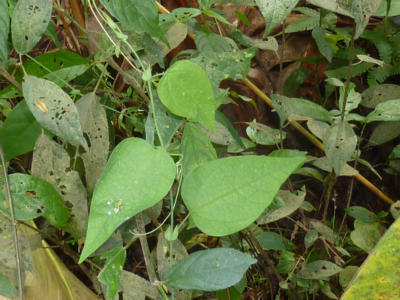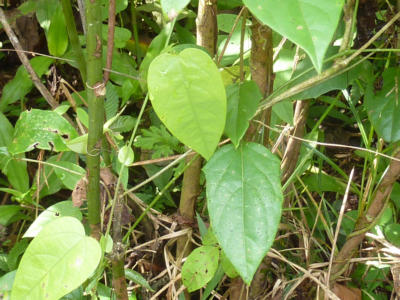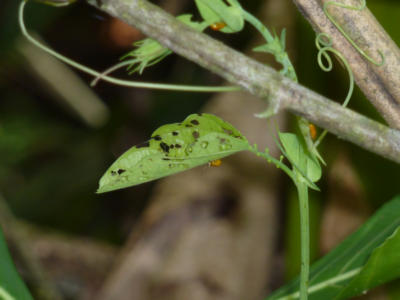Passiflora oerstedii
P. oerstedii is found mainly in second growth areas and on the edges of clearings. The leaf petioles bear long stalked nectaries and are often visited by parasitic hymentoptera such as Trichogramma or scelionid egg parasitoids. The nectaries are very similar in structure and function to those of its relative P. menispermifolia, which shares section Granadillastrum with P. oerstedii. Range: Southern Mexico to Bolivia and Venezuela; wet forest second growth edges and open areas up to 2000 meters elevation.
P. oerstedii foliage is not measureably cyanognic when crushed, nor are the stems or green fruits. (<0.02μM HCN per gram plant tissue). However, Spencer 1988 reported finding the simple monoglycoside cyanogen Gynocardin in P. oerstedii, and Engler (2007) verified this assessment as well as suggesting the presence of small amounts of an unnamed sulfated monoglycoside cyanogen. Rootlets release measureable amounts of HCN (.16-.21 μM/g)
H. cydno, H. hecale, and H. melpomene lay their eggs on P. oerstedii at La Selva, the former two species on the tendril tips and the latter laying her eggs on the shoot tips among the incipient leaves and on the leaf blades. The latter behavior probably protects the eggs by hiding them from the egg parasitoids. Although H. melpomene specialization on oerstedii may be partly "ecological," arising from the distinctive petiolar nectaries attracting egg parasitoids (Smiley 1978), there is also a strong possibility of distinctive cyanogen chemistry between melpomene and oerstedii (Engler 1998).
Flea beetles like this plant, including the Blue Flea Beetle (Monomacra violacea), the Yellow-tibia Flea Beetle (Parchicola "yellow-tibia") and the Yellow Ptocadica (Ptocadica "yellow"). The Yellow-legged Flea Beetle (Parchicola DF2) has also been found once on this species. This is in strong contrast to the related P. menispermifolia, which is not eaten by flea beetles. The Yellow-tibia Flea Beetle (Parchicola "yellow-tibia") has been found to reproduce when placed in an isolation cage with P. oerstedii. The eggs are laid on the underside of old leaves near the base of the plant, and the distinctive larvae feed on the basal stems and/or the superficial roots. They chew into the pithy material of the stem, potentially damaging the plant severely. The larvae then pupate in the soil near the plant base. When the adults emerge they crawl up onto the plant and begin feeding.

P. oerstedii leaf punctured with flea beetle feeding damage.
Note the 2mm long nectaries on the leaf petioles.
These attract egg parasitoids.
These attract egg parasitoids.

the heart-shaped leaves and heart-shaped stipules are distinctive
The large nectar chamber. This attracts large bees, and ants if they can chew their way in past the filaments.


Here are some black-legged Parchicola DF1 small flea beetles actively feeding.